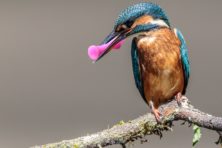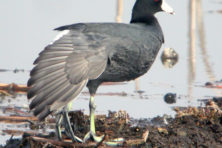Bohemian Waxwing – Beau Brummell of the Bird World
- Share
- Tweet
- Pin
- Share
The Wisconsin Society for Ornithology’s winter finch report for 2012-2013 indicates that one species that should be seen throughout the state this winter is the Bohemian Waxwing. Being of Bohemian descent, I went to the dictionary to get a better understanding of what a Bohemian is.
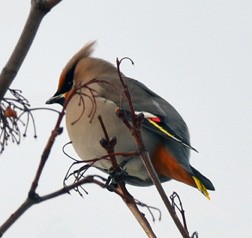
White wing bars, yellow wing feather edges, red wax-like feather tips and yellow tail band are good field marks for the Bohemian Waxwings.
A Bohemian is said to be a vagabond, gypsy, individualistic, easy going, and eccentric at times in their living that reflects protest against indifference to social convention. A vagabond or gypsy I am not, but the other characteristics fit me quite well. These well-dressed birds surely are birds of mystery in that you never quite know when or where you will see them. About the only place in the lower 48 states you most often have a good chance off encountering them is in the Rocky Mountain states.
It’s a shortage of food and not cold weather that drives these birds southward and eastward, much like the rare Northern Hawk Owl that has been near Q and 57 in northern Door County since at least last November 24 – and is still there as of today, January 8. Records prove that Bohemian Waxwings can withstand extremely cold temperatures as long as food is available, a good variety of wild fruits. About the only time they do feast upon insects is during warmer weather and especially during nesting when, like most other songbirds, their young in the nest are fed primarily insects or some form of them such as caterpillars.
I looked into my first copy of Peterson’s Field Guide to the Birds of Eastern U. S. which I bought early in 1954 and just about wore it out before buying a newer edition of this famous guide. The reason I continue interest in my 1954 copy is that I wrote many notes in the margins of pages and especially next to species giving date first seen and often along with interesting observations.
There are only seven entries and dates of seeing Bohemian Waxwings between 1958 and 1982. What a close-knit little roving band of “gypsies” they are, outwardly appearing to be possessed with a high degree of wanderlust. My field records show that the first Bohemian Waxwings I ever saw were sighted along the Lake Michigan shoreline north of Two Rivers at the extreme northern edge of the Point Beach State Forest. I had come to help my good friend John Kraupa, high school biology teacher, with his Two Rivers Christmas Bird Count.
The exact words of my entry read: “spotted north of Point Beach State Forest on Dec. 30, 1958 – Two Rivers Christmas Bird Count—seen at about 4 p.m. with late afternoon sun on them – beautiful! They were feasting on some wild grapes. Watched through scope at about 30 feet.”
My next view of these vagrant aristocrats was on Nov. 26, 1961 as they picked tiny bits of gravel along a road west of Green Bay. Many Wisconsinites saw these irregular cold-weather wanderers that winter.
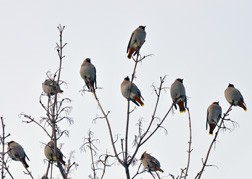
Wandering Bohemian Waxwings, bellies probably full, rest before they go in search of their next meal.
Forty of them were seen by Charlotte and me in early March of 1973. Our Christmas count of 1977 turned up another 45. A welcome flock of them kept me company as I raked leaves in late November of 1980 at our friends’ home along the bluff north of Ephraim. Their soft, buzzy, metallic trills, almost a non-stop chatter, were most pleasant to hear.
The Dec. 19 Christmas Bird Count of 1981 produced the largest flock, 73 of the sociable fruit eaters. A call from a friend living east of Ephraim announced a flock of the “Bohemians” in her back yard. Armed with a slide camera and telephoto lens, a skittish flock of about 40 let me approach to within about 75 feet to get some photographs. Mixed in with the flock were several Pine Grosbeaks.
My last picture of the birds in flight clearly shows their rather long pointed wings. I am extremely fond of their strong, graceful, undulating flight. The birds had been attracted to the fruit of an ornamental crabapple tree, pure ambrosia to these winter apple pickers!
It was easy to see every field mark at that close range, grayish underparts, very black chin, white wing bars, yellow edges of their primary wing feathers, and their cinnamon-colored under-tail coverts. Some of the secondary wing feathers have red wax-like tips at their ends, giving the species its waxwing name. The number varies from bird to bird, anywhere from two to seven. A yellow-tipped tail and a jaunty crest add aristocracy to the bird. Talk about a Beau Brummell of the bird world!
Their winter diet includes rose hips, sumac fruit, kinnikinnick, nightshade, mountain ash berries (a favorite), dogwood fruit, bittersweet, wild grapes, cedar and juniper “berries,” flowering crabapple fruit and others. Another great favorite whenever they can find some are the small fruits of the Cotoneaster (co-TOE-ne-AS-ter). This is a small hardy, ornamental shrub having beautiful white or pink flowers. With care it does very well in this northern climate as has been proven by good friends of ours.
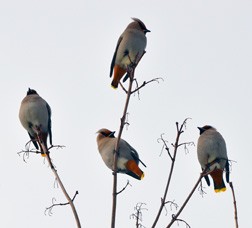
Their rust-colored undertail feathers distinguish them from the Cedar Waxwings.
In view of the fact that most of their winter diet consists of fleshy fruit, (not very nutritious), these black-masked opportunists may have to eat three times their body weight in food every day as long as their diet cannot be supplemented with insects. It has been determined that the average bird eats about one-fourth of its body weight in food daily. The Bohemian Waxwings obviously must be able to pass this great amount of food through their digestive tracts rather quickly. A study showed that fruit fed to young waxwings passed through their bodies in as little as 16 minutes.
It is said that the Bohemian Waxwing’s call note is “buzzy” while in flight it gives forth with a trilly “zir-r-r-r.” Being so highly Bohemian or nomadic, they never developed the need for a true song used to establish nesting and feeding territories. They are nearly always on the go.
Undoubtedly, the fact that my ancestors came from Bohemia makes me somewhat prejudiced toward these birds. Then, too, it is said that absence makes the heart grow fonder. Who knows, it may be another 10 or more years before these elegant wide-roaming birds of mystery return to this area. So until that day I’ll simply say, “So-long, you beautiful Bohemians!”


